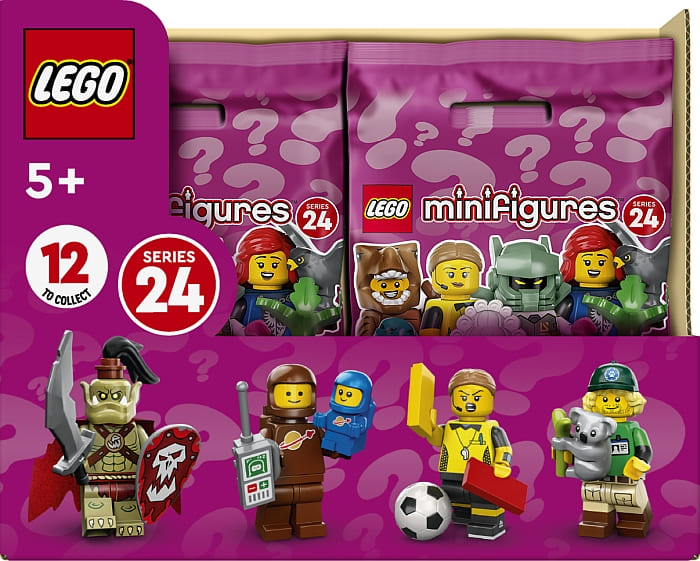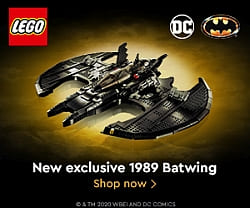I hope you had a wonderful Thanksgiving! If you’re looking for some LEGO deals this weekend, check out the Black Friday/Cyber Monday offerings from LEGO and other retailers.

➡ LEGO STORES & ONLINE LEGO SHOP: Official LEGO stores and the Online LEGO Shop are the safest and surest way to get the LEGO sets you want. During the Black Friday/Cyber Monday weekend, here are the specials offered by LEGO directly.

You will get a free #40563 LEGO Tribute to LEGO House set with purchases of $250 or more until November 27th at official LEGO stores and the Online LEGO Shop.
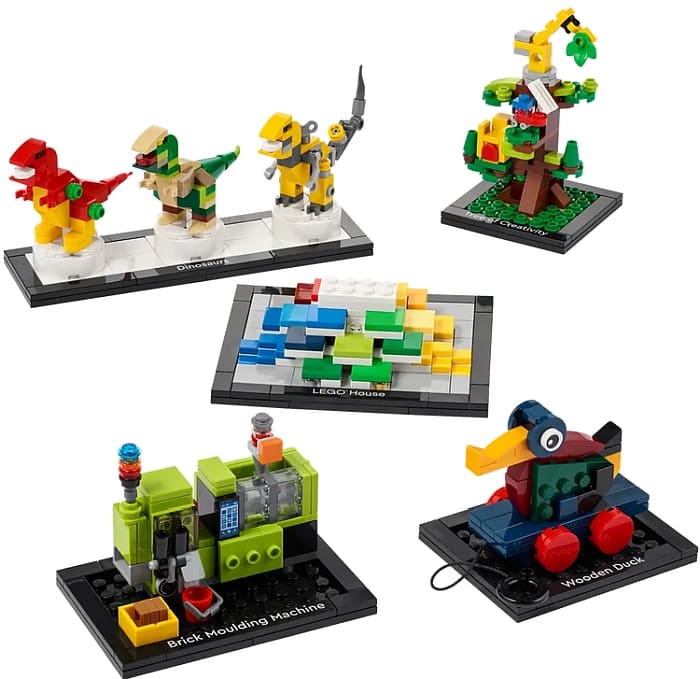
You will also get a free #40564 LEGO Winter Elves Scene with purchases of $170 or more until November 28th at official LEGO stores and the Online LEGO Shop.
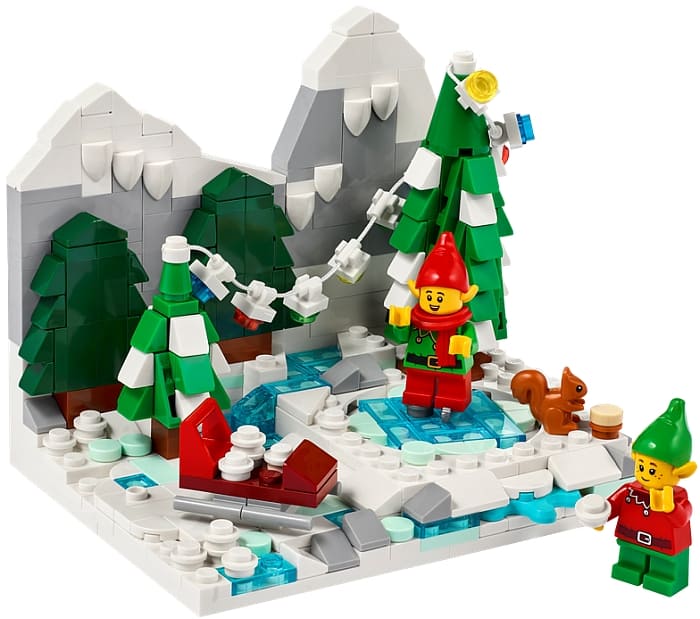
There is an in-store-only promo as well; the #30580 LEGO Creator Santa Claus with purchases of $40 or more until November 28th.
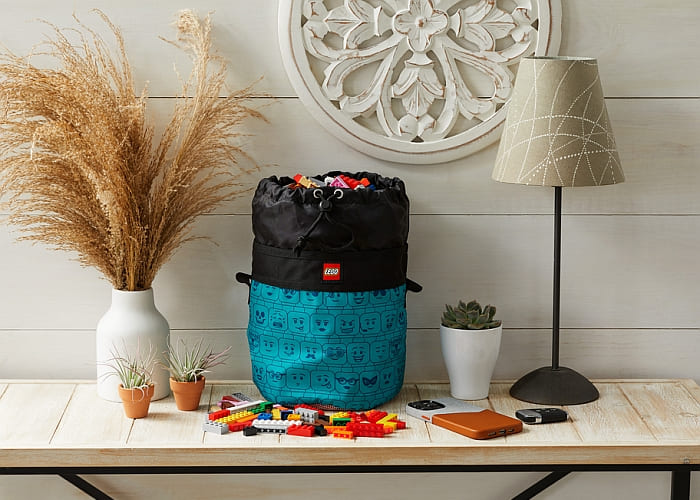
On Cyber Monday (November 28th) only, LEGO VIP members will get a #5007488 LEGO Drawstring Brick Bag with purchases of $200 or more. This offer is only available at the Online LEGO Shop.

There are several other rewards available for LEGO VIP members during the Black Friday shopping event. For 2,400 LEGO VIP points, you can get the exclusive #6427894 LEGO Dragon Adventure Ride set we talked about just a few days ago. You can also win one million LEGO VIP Points, download a Hulkbuster blueprint for 50 LEGO VIP Points, and get a 1958 retro LEGO logo key chain for 950 LEGO VIP Points. For more details, visit the LEGO VIP Reward Center.

Another freebie is the #40579 LEGO Eiffel’s Apartment with purchases of the newly released #10307 LEGO Icons Eiffel Tower. We talked about this set recently, but to recap, this is the tallest and largest piece-count LEGO set ever released. It’s available at the LEGO Icons section of the Online LEGO Shop.
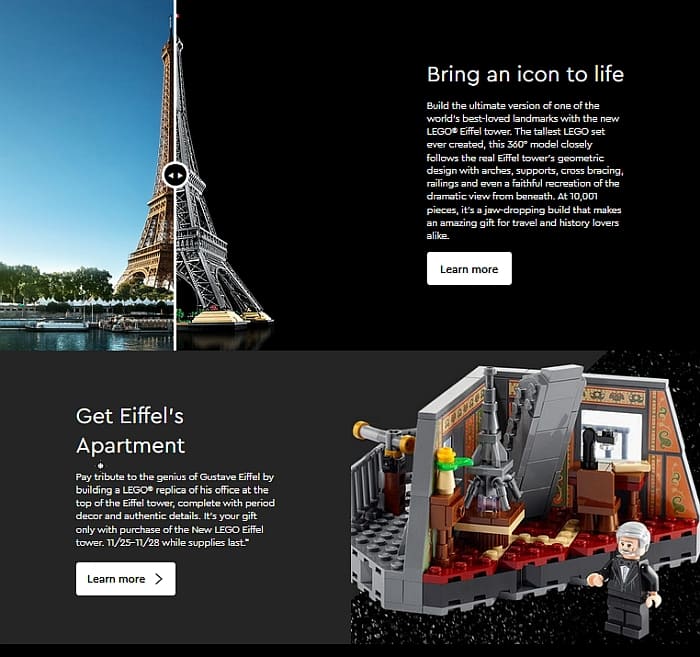
If you are not accustomed to using the Online LEGO Shop, or you have friends/relatives who are going to be purchasing LEGO for you, the online LEGO Gift Finder can be a big help. This is a special section of the Online LEGO Shop that assists shoppers to narrow down their selection by age range, price, and interests. Below are some quick links to help you get started.
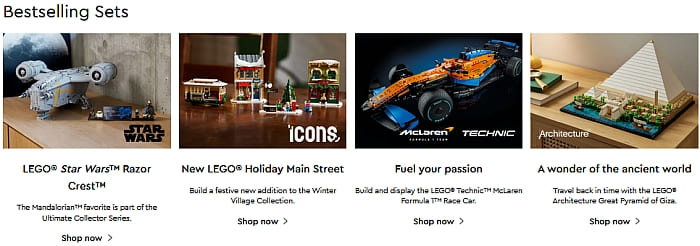

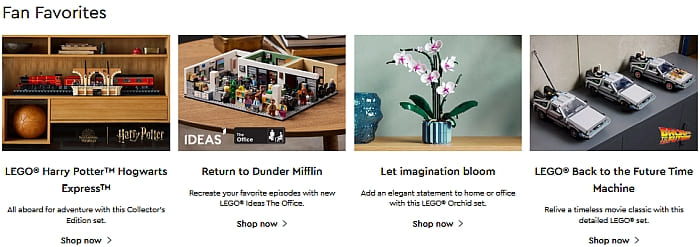

➡ WAL-MART, TARGET & OTHER RETAILERS: These are the generic big-box retail stores. They have a decent selection of LEGO sets, their prices aren’t inflated (although it’s always a good idea to double-check), and they usually have great deals around the holiday season in the 20-50% off range. One tip I would give is that don’t take the shelf prices for granted. There are often sales going on which are not yet marked on the shelves (especially around this time of the year when stores are so busy). Take items up to a price-checking station to get the most current price. Also, don’t forget to check the websites of these retailers, as they often have online-only deals during the holiday season.
➡ SHOPPING FOR LEGO AT AMAZON.COM: One of the best places to shop for LEGO, especially around the holidays, is Amazon.com. Their prices are excellent, as they like to undercut – or at least match – everyone else. As a caveat, always look for the Eligible for Free Shipping icon in the item description. These are items shipped directly by Amazon. (Amazon also has affiliates and their shipping may not be free and/or their service may not be as reliable.) Amazon has a dedicated LEGO store section, with all the currently available sets. Below are some quick links to help you get started:

➡ SHOPPING FOR RETIRED, USED & BULK LEGO: If you have your eyes on a retired LEGO set, or just want to pick up some used or bulk LEGO, eBay.com and BrickLink.com are the best places to shop. Always check the seller’s feedback and if you’re not sure about something, ask questions before making a purchase. One thing to remember when shopping on eBay and BrickLink is that these are usually small hobby sellers who will need to pack and ship your order during their spare time. Also, there have been significant shipping delays due to the pandemic, so place your orders at least 2-3 weeks before Christmas to make sure the package arrives on time.
➡ RECENTLY RELEASED EXCLUSIVE SETS: Here is a list of all the most talked about sets that were released in the past couple of months you may consider for the holidays. The #10308 LEGO Holiday Main Street, the #21337 LEGO Ideas Table Football, the #21336 LEGO Ideas The Office, the #76210 LEGO Marvel Super Heroes Hulkbuster, the #76215 LEGO Marvel Super Heroes Black Panther sculpture, the #75331 LEGO Star Wars Razor Crest, and many other new sets under LEGO City, LEGO Creator 3-in-1, LEGO Disney, LEGO Friends, LEGO Harry Potter, LEGO Ninjago, LEGO Star Wars, LEGO Super Mario, and LEGO Technic. To see the full list visit the new items section of the Online LEGO Shop.

If you already know what you want to get, shopping online is usually the best, most convenient, and safest option. Most retailers offer free shipping, or a very low shipping threshold, during the holiday season to encourage online orders, and they offer the same or even better specials online as in stores. Also, when shopping with online retailers like Amazon, you can pick up other non-LEGO items at the same time which is super convenient.

I hope this guide helps you in your holiday LEGO shopping. If you would like to add your own LEGO shopping tips feel free to share them in the comment section below, along with any great deals you run across between now and Christmas. Happy huntin’!
And you might also like to check out the following related posts:
- Huge LEGO Eiffel Tower Press-Release
- LEGO Avatar: The Way of Water Sets Overview
- Brick Breakdown: LEGO Ideas Table Football
- November 2022 – New LEGO Sets & Promotions
➡ LEGO SHOP IN USA: Online LEGO Shop USA
➡ LEGO SHOP IN CANADA: Online LEGO Shop Canada
➡ LEGO SHOP IN UK: Online LEGO Shop UK
➡ LEGO SHOP AUSTRALIA: Online LEGO Shop Australia


